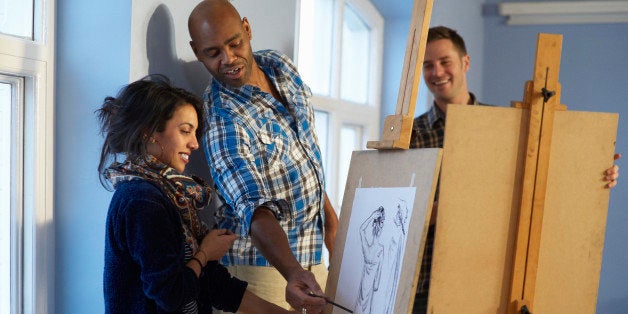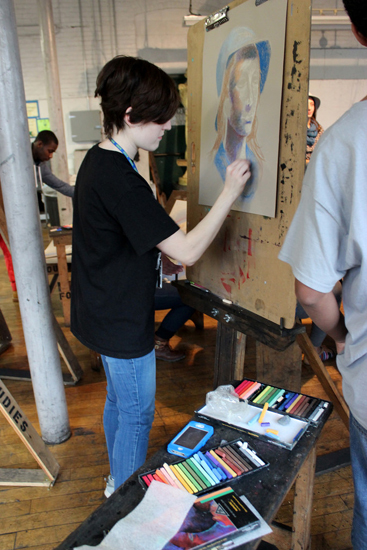
"I presently enjoy the rare chance to teach drawing in my math class. We have discussed perspective and symmetry so my math students are working on drawing in perspective. After teaching high school math classes for almost ten years, I am more than ready to get out. I would like to teach art or digital imaging at the high school level. However, I feel trapped in this high-demand, high-pressure, test-obsessed field with no room for advancement or creativity. Although I could obtain a certification to teach art in my state, I have never been to art school. I suppose my question is about how feasible this is. Could a math teacher teach art?"
Technically speaking, if you obtain the required certification and degrees to teach studio art, you can do it. However, being an effective art teacher is much more than degrees and certification. A huge part of being a successful art teacher is the ability to draw from your own experience as a visual artist. You can read, write, and analyze all you want about art theory, art technique, art education, etc., but until you have the hands-on experience of actually making your own artwork, your ability to teach studio art will remain superficial. The equivalent would be a soccer coach who reads about soccer techniques, but has never physically played a soccer game.
Teaching studio art at the high school level has its own unique set of challenges. Most high school art teachers teach general art courses that cover a wide range of techniques. For this reason, you need to have expertise in multiple techniques: drawing, painting, sculpture, and more. You have to know all of these processes inside out, which requires many years of working with those techniques through your own artwork. Teaching a course as specialized as digital imaging at the high school level would be rare, usually only private preparatory schools are able to offer a course like that.
There are many aspects of creating your own artwork that would tremendously inform your capacity to teach studio art. Troubleshooting is a significant part of creating your own artwork, and you will learn much more from your mistakes than from your moments of success. For example, it took me years of mistakes to figure out a reliable technique for stretching canvases. Despite technical demonstrations by my teachers, I made many errors: my canvases were too loose; I didn't accurately measure my rabbitskin glue sizing which resulted in cracked oil paintings, etc. It was only after making these blunders that I could see what was required to execute the technique properly. These experiences are critical to being an art teacher because you acquire practical strategies for difficult problems.
So much of my time as a teacher is devoted to showing students how to fix things when something doesn't work out. Students will make mistakes, and you have to be able to provide your students with options no matter what goes wrong. The demonstrations I give emphasize ways of dodging potential problems. As much as I try to anticipate problems, new issues always arise that you could never foresee. One of my colleagues told me that a student once accidentally ran a pencil through a printmaking press! Since hearing this story, I am adamant about telling students that absolutely nothing is ever allowed on a printmaking press other than the press blankets. Being told what to avoid is just as important as being told what to do.
Making art is usually a very physical process, and seeing a professional in action can be tremendously influential. The individual demonstrations I give to my students can have a greater impact than any verbal description I can provide. In my drawing classes, I often ask students to simply watch my body movements while I draw. I tell them to not look at the drawing I'm making, but instead to see the direction my wrist moves in, the sweeping motions I make with my arm, and to observe the swift pacing of my movements. These physical actions could never be portrayed in a book, they simply have to be experienced in real life and can only be demonstrated by someone who has done it many times before.
Essentially, you have to be an artist before you can be a studio art teacher. Students look to their teachers to be role models, and they need to see that their teachers have active studio practices. This makes the idea of being a professional artist real for students. Initiate your career change by building your own history as a working artist. Collect your own tricks of the trade, and share those experiences with your students. Inhabiting both roles as artist and teacher will enrich your art students beyond measure.
Ask the Art Professor is an advice column for visual artists. Submit your questions to clara(at)claralieu.com

